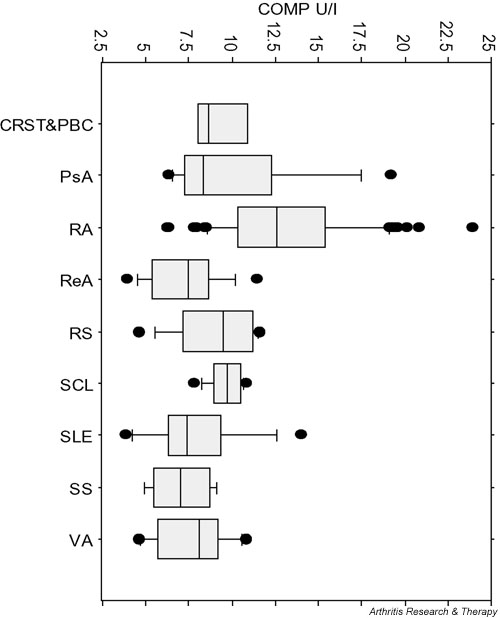Progressive bone and cartilage destruction in arthritic joints leads to irreversible joint destruction and, subsequently, to functional declines and to work disability. During recent years a lot of interest has been focused on serum biomarkers in the clinic to evaluate the ongoing disease process in the cartilage and bone. New biomarkers such as osteoprotegerin or receptor activator of NF-κB ligand have been developed to describe the local bone process in affected joints.
Cartilage oligomeric matrix protein in serum (sCOMP) is a biomarker for the cartilage turnover [1] and is elevated in patients with rheumatoid arthritis (RA), in patients with osteoarthritis and in patients with articular trauma. sCOMP is a valuable parameter for the assessment of therapy response in RA [2]. Elevated serum levels of sCOMP showed a significant correlation with the progression of the Larsen score within 5 years in a patient group with established RA, and sCOMP is also described as a prognostic factor in early RA [3,4]. Inflammatory synovium has been considered a potential tissue source of sCOMP since the molecule has been detected in the synovium in both RA [5,6] and osteoarthritis [6]. However, less is known of how much sCOMP the synovium produces in other inflammatory rheumatic diseases.
The aim of our study was to investigate whether increased sCOMP is a specific marker for joint destruction, comparing sCOMP between patients with RA and patients with other inflammatory rheumatic diseases with less cartilage-destructive arthritis.
Levels of sCOMP and serum C-reactive protein (CRP) were measured in 150 patients. Seventy-seven of the patients had seropositive erosive RA, fifteen patients had psoriatic arthritis (PsA), ten patients had reactive arthritis, twelve patients had primary Raynaud's syndrome, eleven patients had scleroderma, nine patients had systemic lupus erythematosus, seven patients had leucozytoclastic vasculitis, five patients had primary Sjögren's syndrome and four patients had CRST (calcinosis, Raynaud's syndrome, scleroderma, teleangiectasia) syndrome and primary biliary cirrhosis. Cartilage oligomeric matrix protein was measured with an ELISA according to the recommendation of the manufacturer (cut-off point, 10 U/l; AnaMar Medical AB, Uppsala, Sweden). Statistical evaluation was calculated by paired t test.
Elevated sCOMP levels were detected only in patients with RA and with PsA. We found a significant difference between sCOMP in patients with RA and PsA (P = 0.01), in patients with reactive arthritis (P = 0.0001), in patients with Raynaud's syndrome (P = 0.0005), in patients with scleroderma (P = 0.003), in patients with systemic lupus erythematosus (P = 0.0002), in patients with leucozytoclastic vasculitis (P = 0.0004) and in patients with Sjögren's syndrome (P = 0.0007), but not in patients with CRST syndrome and primary biliary cirrhosis (P = 0.06) (Fig. 1). sCOMP did not differ significantly between Steinbrocker stages II–IV in RA patients. Levels of sCOMP were not significantly associated with CRP (P = 0.78).
Figure 1.

Serum levels of cartilage oligomeric matrix protein (COMP) in rheumatoid arthritis (RA) and other inflammatory rheumatic diseases. PsA, psoriatic arthritis; ReA, reactive arthritis; RS, Raynaud's syndrome; SCL, scleroderma; SLE, systemic lupus erythematosus; VA, leucozytoclastic vasculitis; SS, Sjögren's syndrome; CRST&PBC, CRST syndrome and primary biliary cirrhosis.
Cartilage oligomeric matrix protein is described as an indicator for the current extent of cartilage destruction in RA. In our patient group elevated levels of sCOMP could only be detected in patients with RA and in a few patients with PsA, but not in patients with reactive arthritis, with Raynaud's syndrome, with scleroderma, with systemic lupus erythematosus, with leucozytoclastic vasculitis or with Sjögren's syndrome. This result indicates that among these inflammatory arthritic diseases cartilage is affected only in RA. In none of the diseases was sCOMP associated with inflammation markers such as CRP. This is not in agreement with other studies where elevated cartilage oligomeric matrix protein levels were found even in patients with low clinical prognostic factors (erythrocyte sedimentation rate, CRP, rheumatoid factor, disease activity score). However, a correlation between sCOMP and the delta Larsen score over 5 years in this patient group could be demonstrated.
Our results further confirm the conclusion that sCOMP levels are highly specific markers for the cartilage degradation process in RA [6,7] and are not related to a nonspecific inflammatory process in an arthritic joint.
Competing interests
None declared.
Abbreviations
CRP = C-reactive protein; ELISA = enzyme-linked immunosorbent assay; NF = nuclear factor; PsA = psoriatic arthritis; RA = rheumatoid arthritis; sCOMP = cartilage oligomeric matrix protein in serum.
References
- Oldberg A, Antonsson P, Lindblom K, Heinegaard D. COMP (cartilage oligomeric matrix protein) is structurally related to the thrombospondins. J Biol Chem. 1992;267:22346–22350. [PubMed] [Google Scholar]
- Crnkic M, Mansson B, Larsson L, Geborek P, Heinegard D, Saxne T. Serum cartilage oligomeric matrix protein (COMP) decreases in rheumatoid arthritis patients treated with infliximab or etanercept. Arthritis Res Ther. 2003;5:181–185. doi: 10.1186/ar760. [DOI] [PMC free article] [PubMed] [Google Scholar]
- Skoumal M, Kolarz G, Klingler A. Serum levels of cartilage oligomeric matrix protein (COMP): a predicting factor and a valuable parameter for disease management in rheumatoid arthritis. Scand J Rheumatol. 2003;32:156–161. doi: 10.1080/03009740310002498. [DOI] [PubMed] [Google Scholar]
- Forslind K, Eberhardt K, Jonsson A, Saxne T. Increased serum concentrations of cartilage oligomeric matrix protein. A prognostic marker in early rheumatoid arthritis. Br J Rheumatol. 1992;31:593–598. doi: 10.1093/rheumatology/31.9.593. [DOI] [PubMed] [Google Scholar]
- Hummel KM, Neidhart M, Vilim V, Hauser N, Aicher WK, Gay R, Gay S, Häuselmann HJ. Analysis of cartilage oligomeric matrix protein (COMP) in synovial fibroblasts and synovial fluids. Br J Rheumatol. 1998;37:721–728. doi: 10.1093/rheumatology/37.7.721. [DOI] [PubMed] [Google Scholar]
- Di Cesare PE, Fang C, Leslie MP, Della Valle CJ, Gold JM, Tulli H, Perris R, Carlson CS. Localization and expression of cartilage oligomeric matrix protein by human rheumatoid and osteoarthritic synovium and cartilage. J Orthop Res. 1999;17:437–445. doi: 10.1002/jor.1100170321. [DOI] [PubMed] [Google Scholar]
- Dodge GR, Hawkins D, Boesler E, Sakai L, Jimenez SA. Production of cartilage oligomeric matrix protein (COMP) by cultured human dermal and synovial fibroblasts. Osteoarthritis Cartilage. 1998;6:435–440. doi: 10.1053/joca.1998.0147. [DOI] [PubMed] [Google Scholar]


